The annual Consumer Electronics Show (CES) in Las Vegas has long become one of the main innovative platforms for demonstrating consumer electronics. Of course, the high-tech TVs are always in the spotlight. Along with demonstrating updated model lines, industry leaders are presenting new technological concepts. OLED Evo panel in LG OLED G1 (2021), mini LED backlight (TCL OD ZERO, LG QNED and Samsung Neo series, 2021), hybrid QD-OLED panels in Samsung S and Sony A series (2022), wireless LG M3 с MLA technology has amazed experts in previous years. This year was no exception. The LG, Samsung, TCL, Sony, and Hisense fully met the public’s expectations, by introducing transparent LG OLED T and Samsung micro LED panels, QDEL (Quantum Dot Electroluminescent technology) panels, newest NQ8 AI Gen3 NPU in Samsung Neo QLED 8K, huge mini LED TCL and Hisense TVs, etc.
To be fair, they are unlikely to become bestsellers due to the high price. However, OLED Evo, mini LED backlight and hybrid QD-OLED almost immediately demonstrated impressive marketing success.
The transparent LG OLED T, new G4 and M4 with META 2.0 (3rd generation) OLED panels were the center of attention at the South Korean giant’s stand.
LG TVs 2024 run the latest webOS 24 version with support of Apple AirPlay, Google Chromecast and Smart Home Standard with Internet of things (IoT) Matter. In addition, the company offers a five-year upgrade program for webOS called Re:New. It will start this year and will be available for QNED / OLED TVs starting in 2022.
The OLED line includes the B4, C4, G4 and M4 series TVs with a diagonal of up to 97 inches and 4K UHD resolution. All series are Intertek certified, which guarantees a response time ≤ 0.1 ms, Adobe RGB gamut coverage > 90%.
Main innovations
The list includes:
1- META 2.0 (3rd gen).
The Micro Lens Array (MLA) was first introduced at last year’s CES in the flagship G3. According to LG Display, the peak brightness of the new version can reach up to 3,000 nits in a 3% window, which is more than 40% higher than the brightness of previous OLED panels. In fact, the limited brightness of OLED technology is already a thing of the past.
As known, MLA uses a layer of tiny convex microlenses between the glass and the OLED panel.
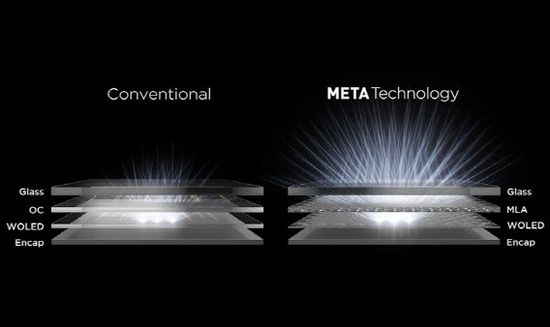
By focusing light from the panel, they reduce internal reflections, increasing the brightness, energy efficiency and viewing angles of OLED displays.
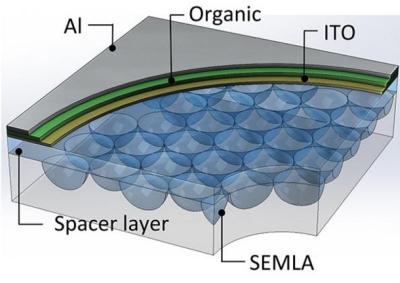
For example, a 77″ panel uses 5,000 microlenses per pixel.
In addition, MLA OLED panels use heatsink for additional heat dissipation. Improved MLA+ was developed based on light efficiensy data analyzes. All META 2.0 panels support LG Display’s ‘META Multi Booster’ with 5 fine tuning algorithms. Essentially, this feature optimizes peak and color brightness at the pixel level. According to the developers, the brightness increase can reach 70%.
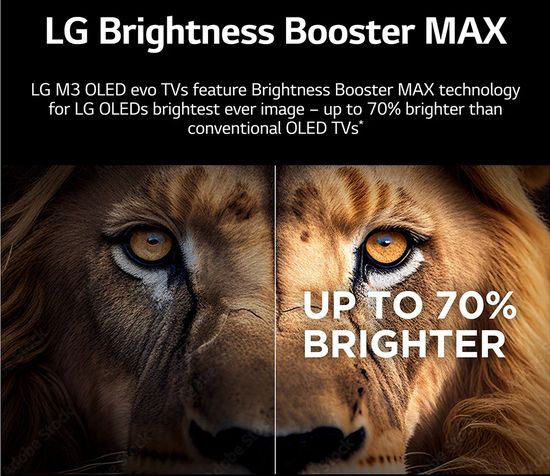
LG Display plans to produce META 2.0 panels from 55″ up to 83″ with 4K resolution, and 77″/ 88″ for 8K. In addition, LG Display began using the MLA in the new gaming OLED panels.
2- latest α11 AI video processor.
α (Alpha) 11 AI:
– 70% improvement in graphic performance and a 30% faster processing speed;
– new Peak Highlighter feature;
– AI Picture Pro – new Object Enhancing by Visual Perception with pixel-level optimization and AI Director Processing (‘Director Tone’ mode with max authentic playback);
– AI Sound Pro – virtual 11.1.2 surround upmixing vs 9.1.2 in the G3.
LG Signature OLED T
Of course, the transparent 77-inch LG Signature OLED T became one of the sensations of CES 2024. To be fair, its price and too futuristic design are unlikely to allow it to take a place among the bestsellers. But showcasing the progress of new concepts is one of the CES’s functions, and the South Korean giant accomplished this mission very well.
The Signature OLED T makes a fantastic impression, but its design is quite simple. In fact, it has a transparent front OLED panel with an opaque folded film (‘contrast screen’). This panel turns into a traditional TV after unfolding the film behind the image.
In fact, the technology can be positioned as an improved version of the Samsung Frame series concept, which turns the TV into a decorative element. In this case, Signature OLED T in ‘transparent’ mode turns into, for example, a colorful virtual flame.
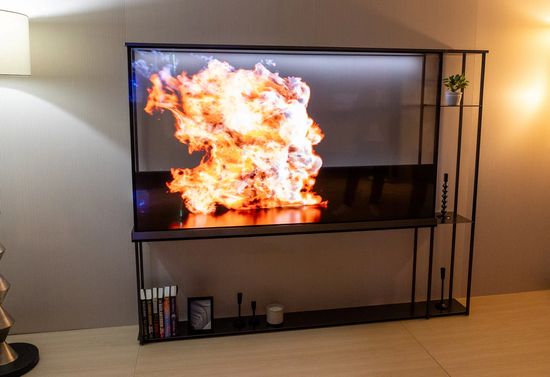
Moreover, it offers T-Bar feature for news and information.
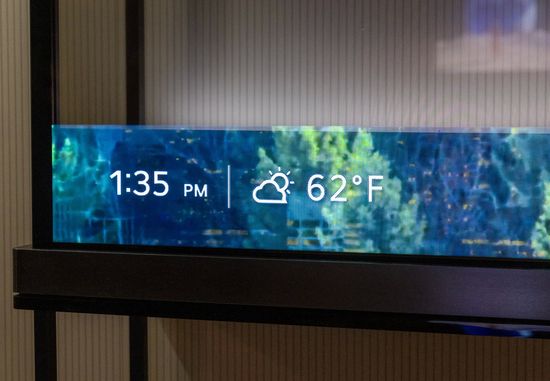
Like the LG M3 / M4, Signature OLED T comes with Zero Connect box for wireless Video/Audio transmission to TV. In fact, the model embodies a full range of the latest TV innovations, including transparent OLED display, wireless Zero Connect box and a new user interface.
Pros
– innovative transparent-to-opaque display and Zero Connect box;
– superb picture quality.
Cons
– too high price (presumably);
– only one screen size.
Wireless OLED M4 and UltraGear Dual-Hz gaming monitor
The wireless OLED M4 with an additional external Zero Connect box for broadcasting V/A content has become a brighter version of last year’s M3. It has additional heatsink and MLA (Micro Lens Array)-based META 2.0 OLED panel with ‘META Multi Booster’ (pixel-level brightness optimization) feature. As a result, its peak brightness can reach an unprecedented 3,000 nits in a 3% window, which radically solves the problem of limited brightness of OLED panels.
In addition, M4 uses new α11 AI video processor.
LG also introduced the 32″ 4K OLED UltraGear 32GS95UE gaming monitor with Dual-Hz function. In fact, it supports 4K(3,840×2,160)@240Hz and unprecedented FullHD (1,920×1,080)@480Hz for high frame rate gaming.
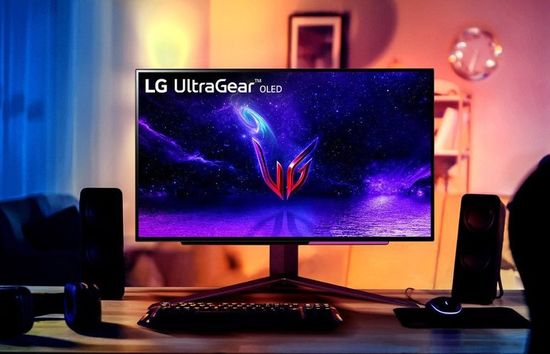
Of course, its main specs are also premium:
– up to 1,300 nits peak brightness;
– 98.5% DCI-P3 color gamut;
– 0.03 ms GTG (‘Grey-to-Grey’) response time – determines the processing speed of fast-moving images (~1 ms is a good);
– superb black with DisplayHDR True Black 400 standard support (guarantees high HDR performance when playing HDR content);
– 2x HDMI 2.1 (but only DisplayPort 1.4 up to 25.92 Gbps);
– built-in audio system (screen surface as an acoustic vibrator + two woofers, headphone jack, Pixel Sound and DTS Virtual:X support).
Conclusion
The list of major LG’s innovations 2024 includes:
– transparent LG OLED T;
– unprecedented peak brightness up to 3,000 nits in the models up to 83″ with MLA-based OLED META 2.0 3rd gen panel (META Multi Booster);
– newest α11 video processor;
– Chromecast and 144Hz in all OLED models (except B4);
– 32″ 4K OLED UltraGear Dual-Hz gaming monitor with FullHD@480Hz support and 1,300 nits peak brightness.
Each of them can rightfully be positioned as the next technological breakthrough that will ensure future progress.
But, of course, the company also introduced more affordable, improved models from last year without revolutionary technologies. This list, for example, includes OLED C4 / B4 and QNED series. As known, LG QNED series offers LCD TVs with mini LED backlight and QD-based NanoCell technology. Of course, competition in this new ultra-popular segment is very high. For example, last year its range expanded with the magnificent Hisense U8K, TCL QM8 and, of course, the amazing Samsung Neo series. But competition even with the most formidable rivals is unlikely to confuse the South Korean giant.
This video demonstrates the brightest OLED TV with META 2.0 technology.
